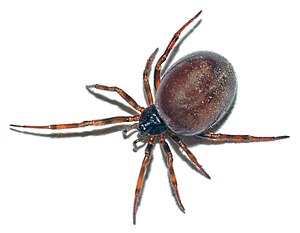Common fat spider
| Common fat spider | ||||||||||||
|---|---|---|---|---|---|---|---|---|---|---|---|---|

Common fat spider ( Steatoda bipunctata ), female |
||||||||||||
| Systematics | ||||||||||||
|
||||||||||||
| Scientific name | ||||||||||||
| Steatoda bipunctata | ||||||||||||
| ( Linnaeus , 1758) |
The common or common fat spider ( Steatoda bipunctata ), often simply referred to simply as fat spider , is a species of spider of the same named genus of fat spiders from the family of the canopy web spiders . It is widespread in the Holarctic and occurs in Central Europe mainly in buildings, where it likes to build its networks in dark corners. The largest specimens reach a body length of 8 mm (without legs), but in the majority of cases the animals are much smaller.
The Arachnological Society named the common fat spider Spider of the Year 2018.
description
The common fat spider is reddish and sometimes brown in color. Your body is shiny fat, which is probably where the name comes from. It has two lighter marks on the back of the abdomen, which in females develop into two broad stripes with advancing age. A light, white to yellowish ring extends from the petiolus on the sides to the middle of the abdomen. On the ventral side of the opisthosoma there is a light spot in the area of the epigyne . It is flanked by bright vertical stripes that converge above the spinnerets like a raised horseshoe. The spinnerets are usually clearly visible, but point downwards. The legs are indistinctly ringed in red and brown. A thick hair is revealed under the microscope.
Way of life
The predominantly nocturnal, very shy animals build their nets, which are invisible at a glance or appear confused, in dark corners of buildings, in the open ground near the ground under stones or in crevices. The three-dimensional network, about 10 cm³ in size, condenses into a dense safety mat that is woven between tension ropes at a height of a few centimeters. The tensioning ropes run in an oblique-vertical direction and tension the mat in all directions. These fastenings often branch out once or twice so that the load is distributed across different glue points. These tension ropes serve as stumbling threads for the prey-catching female of S. bipunctata . If prey runs into it, it is lifted up by the tensioned threads and gets stuck there. In this way they are able to overwhelm prey that are much larger than they are. The fat spider - provided it is not hanging upside down in the web during its active hours - is made aware of alarm threads that are stretched to the hiding place. In this hiding place, which is a living space only a few millimeters wide, like a crack in a wall or rock or even a cavity in a window hinge, it retreats during the daylight hours and hides in it when there is potential danger from larger animals, especially through Vibrations are perceived. If the prey falls onto the net from above, it sometimes has to bite holes into it. The prey is wrapped, but not stunned, and later sucked out in stages. The leftover food is then removed from the mat and simply dropped.
The common fat spider can also survive dry periods and can absorb considerable amounts of water in dew drops or condensation water droplets measured by its body size, so it can also grow old in human homes. With a higher population density, neighbors of the same kind are tolerated and the nets are connected to one another, but the largest female retains the best and largest places, which can lead to the neighbors migrating.
Reproduction
The males mostly wander around. During courtship , the net is also used for communication by plucking and for weaving various elements of unclear function by the male; it may be sperm balls. The male loses weight as he weaves astonishing amounts of communication threads before finding the female's web after days of searching.
The males of the species have stridulation organs . With them they generate a three-line cis of 1000 Hz (according to literature, which is also weakly audible for humans) . Males stridulate each other when they compete for a female. During stridulation, the opisthosoma is swiftly rocked, with strong spikes of the opisthosoma being stroked over furrowed areas of skin on the prosoma. The female willing to mate then starts her search and answers with drums and seesaws on the net. The triggers for courtship behavior are, among other things, chemical substances contained in female silk.
The female animals are active all year round in protected locations. The courtship takes place in summer, which can take several days to weeks. The female also mates with two males. The males live together with the females in the female network for a long time during courtship and after mating. The successful males are also given some of the prey there, and they are also allowed to take the wife's retreat, although the female remains in wait on the signal threads in her tarsal claws .
gallery
Female with predator snake
literature
- Willis J. Gertsch : American Spiders. 2nd Edition. Van Nostrand Reinhold, New York 1979, ISBN 0-442-22649-7 .
Individual evidence
- ^ Rainer F. Foelix : Biology of Spiders . 2nd Edition. Oxford Thieme, 1996, ISBN 0-19-509594-4 .
Web links
- Steatoda bipunctata in the World Spider Catalog
- W. Nentwig, T. Blick, D. Gloor, A. Hänggi, C Kropf: Spinnen Europa. www.araneae.nmbe.ch. Version 01.2019.
- Steatoda bipunctata. in the Wiki of the Arachnological Society










